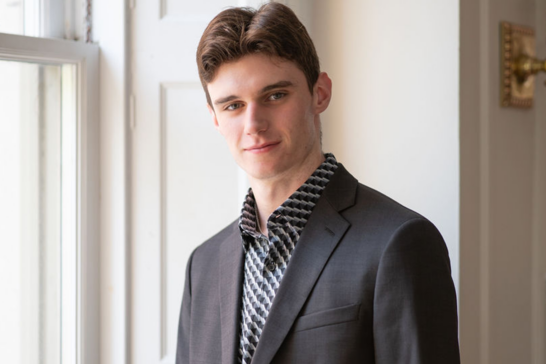Interview with Erinys Quartet’s Stergios Theodoridis

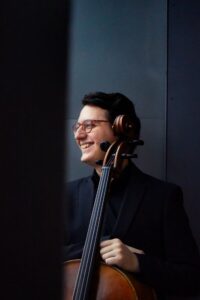 What about the narrative of Aeschylus’ Greek tragedy Oresteia inspired the quartet’s name?
What about the narrative of Aeschylus’ Greek tragedy Oresteia inspired the quartet’s name?
Our quartet name, Erinys, is the singular form of the word Erinyes, which were the furies in Greek mythology. In the Oresteia, as well as in other mythological stories, the Erinyes were three female deities responsible for bringing vengeance and punishment to people (usually men) who did despicable acts. In the Oresteia trilogy, for example, the furies are hunting down Orestis for the crime of killing his mother. In our case, the name is less connected to the Oresteia’s plot and more to the role the Erinyes had in mythology in general, as at the time, our quartet was comprised of three girls and myself, and we thought the idea of the girls being the goddesses inflicting vengeance on me was amusing, so we ran with it. We mention the Oresteia in our bio simply because it’s probably the most famous surviving instance of the Erinyes appearing in ancient Greek literature.
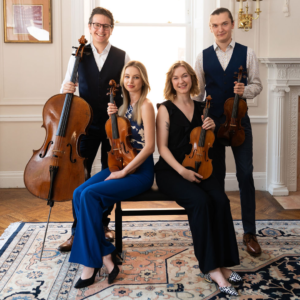 What prompted the four of you to establish the quartet while you were studying at the Sibelius Academy?
What prompted the four of you to establish the quartet while you were studying at the Sibelius Academy?
The four of us didn’t actually know each other before the quartet, with the exception of Marija and me. We decided to start our own quartet and asked two newly admitted students in the academy to play with us, Aida (our original violist who moved on to other things two years ago) and Lizzie, who is, of course, still with us. Of course, then two years ago, Joosep joined us, and Marija became our violist. What kept us together was how easily we communicated musically with each other and how we shared the same passion for being the best string quartet that we could. We really put aside ourselves and do anything necessary for the quartet to develop constantly.
How did you typically choose your current repertoire and what drew you to the repertoire you’re currently playing?
We always try to have a varied repertoire that includes many different musical periods and compositional styles. As an example, this week, we are presenting concerts in two different programs, which include works by Bartók, Beethoven, Britten, Haydn, Webern, Janáček, Saariaho, and Chacon. We consider it especially important to always have a Beethoven quartet from the mid-period and later that we are working on, as we feel Beethoven is the most significant quartet composer and one of the most challenging to get right, and also something classical like Haydn or Mozart. We also enjoy working on contemporary music, which many times demands of us to go way beyond the conventional limits of what kind of sound our instruments can produce. At the end of the day, though, we always pick the pieces that we love the most, and we never agree to play a piece that even one of us does not want to do.
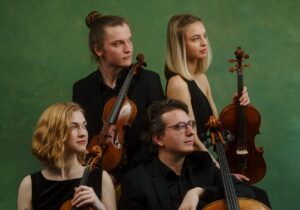 Could you share some of your favorite moments touring and performing as part of your two-year residency here at Curtis so far?
Could you share some of your favorite moments touring and performing as part of your two-year residency here at Curtis so far? 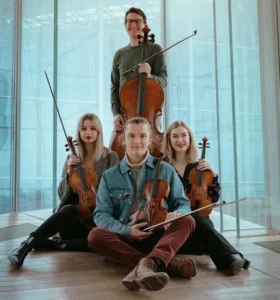 What do you hope to achieve as an ensemble in the years to come?
What do you hope to achieve as an ensemble in the years to come?
In the years after our residency, we hope that our ensemble can have a sustainable and meaningful career as a string quartet. Aside from the practical details that would enable something like this, like doing really well in competitions, getting a teaching residency somewhere, or management, etc., we hope that we can use all the tools that Curtis has provided us with to keep honing our skills, to keep developing our own unique identity and most importantly, to keep doing what is most fun for us: going on the stage to perform.
Visit the Erinys Quartet’s official website HERE.
About Erinys Quartet
Named for the Erinyes (a.k.a. the Furies) from the Greek tragedy Oresteia by Aeschylus, and with roots in Estonia, Lithuania, Greece, the United States, and Finland, the Erinys Quartet was founded in 2018 at the Sibelius Academy in Helsinki, where they worked closely with cellist Marko Ylönen. Since the autumn of 2023, they have been the Nina von Maltzahn String Quartet-in-Residence at the Curtis Institute of Music.
In the 2024–25 season, the Erinys Quartet performs throughout Europe and the United States, with concerts in Greece, Hungary, Germany, Spain, the United Kingdom, New York, New Jersey, Connecticut, Rhode Island, Pennsylvania, Delaware, Virginia, Florida, Minnesota, Colorado, New Mexico, and California. They have also been featured in festivals and concert series such as the Mimir Chamber Music Festival in Fort Worth, Texas; Festival Groba in Ponteareas, Spain; the inaugural Dover Quartet Workshop at Curtis; as well as the Professional String Quartet Seminar with the Pacifica Quartet and Atar Arad (Cleveland Quartet) at Indiana University.
Since 2021, the Erinys Quartet has been supported by Le Dimore del Quartetto, where they are also a part of the European Union-sponsored MERITA platform. In addition to their studies at the Curtis Institute of Music, the members of the Erinys Quartet are pursuing a diploma in chamber music at Escuela Superior de Música Reina Sofía in Madrid, Spain, under the tutelage of Günter Pichler (Alban Berg Quartett).
In 2023, the Erinys Quartet was awarded the Audience Prize Award of the City of Bad Tölz during the Bad Tölz International String Quartet Competition, the Esterházy Foundation Special Prize for best interpretation of a Haydn string quartet and were awarded the Bronze Medal Prize in the 2024 Fischoff Competition.
About Stergios Theodoridis
Stergios Theodoridis, from Thessaloniki, Greece, is a member of the Erinys Quartet, which studies with the Dover Quartet and entered Curtis’ Nina von Maltzahn String Quartet Program in 2023. He began his studies in cello at age seven, under the guidance of Zoran Stepic, with whom he remained as a student until receiving his diploma from the Conservatory of Northern Greece in 2011. In 2002, he was awarded a special prize in the Alumni of the Conservatories of Northern Greece Foundation competition. In 2010, he received third prize in the Jugend Musiziert competition in Lübeck, Germany, in the category of violoncello solo. In 2014, he started his studies in the bachelor’s degree program of the Sibelius Academy in Helsinki, in the class of Raimo Sariola. Since 2017, he has continued working in the master’s program in the studio of Tuomas Ylinen while simultaneously pursuing a music pedagogy diploma. He has participated in master classes with globally acclaimed soloists such as Frans Helmerson, Wen-Sinn Yang, Andreas Brantelid, and Jean-Jacques Kantorow. He has given solo and chamber music recitals in Germany, Austria, Italy, and Finland, as well as in Thessaloniki and Athens in Greece. He has collaborated with orchestras such as the Estonian Sinfonietta, the Turku Philharmonic Orchestra, and the Helsinki Philharmonic Orchestra.
Photos Credits: 1.) Obelixy. 2.) Portrait of Stergios Theodoridis, courtesy of the Mimir Chamber Music Festival. 3.) Nichole MCH Photography. 4.) Anna-Maria Viksten. 5.) Courtesy of the Erinys Quartet.
Interview with Stergios Theodoridis by Ryan Scott Lathan.
